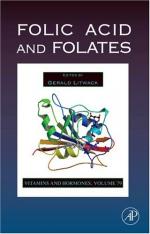|
This section contains 856 words (approx. 3 pages at 300 words per page) |

|
Overview
Folic acid (FOH-lik AS-id) is a member of the B vitamin group, which is essential for the production of proteins and nucleic acids. In pure form, it is a tasteless, odorless, orange-to-yellow crystalline substance that is destroyed by heat or exposure to light. The compound occurs in three similar forms with comparable biological activity. Only one of its forms, l-pteroylglutamic acid, is made synthetically (in a laboratory). Folic acid is sometimes referred to in its ionic form as folate, which differs from folic acid only in the absence of a single hydrogen atom in its structure. The term folate is also used for a group of compounds structurally similar to folic acid.
Key Facts
Other Names:
L-glutamic acid; vitamin Bc; vitamin B9; vitamin M
Formula:
C19H19N7O6
Elements:
Carbon, hydrogen, nitrogen, oxygen
Compound Type:
Organic acid
State:
Solid
Molecular Weight:
441.40 g/mol
Melting Point:
|
This section contains 856 words (approx. 3 pages at 300 words per page) |

|


